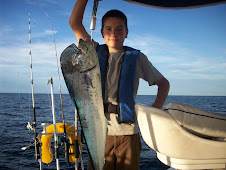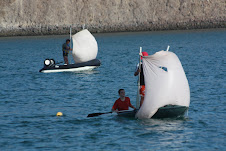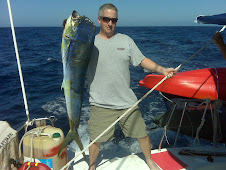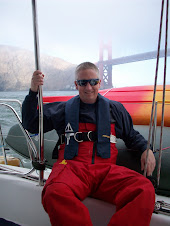"There is an opportunity here that would surely benefit the cruising community! Please consider doing a quick survey of each boat and ask them which anchor they had out when the storm hit and what their rode consisted of. The results of your questions would be a very valuable resource for cruisers everywhere. We only know you had a Manson and it appears to have done a stellar job. It would be good to know which other anchors did their job and which failed, ya know?"
This is a very interesting question, and believe me, I contemplated trying to find all the boats involved and ask them each about their experiences that night, even before reading this comment, just for curiosity's sake. However, there was one big problem with that. As I talked to people in the days after the storm, it became clear that everyone was a "hittee" and no one was claiming "hitter" status. Ah, the dreaded "responsibility" that life in America has pushed on us. Never claim responsibility for any accident, or you get the insurance bill. Don't they teach that as part of Driver's Ed? And some people were embarrassed to say they dragged, something in the cruiser's world that is equivalent to ED.
I know of 8 boats involved in collisions, but I bet there were more. And you can't assume that of those 8, four were hitters and four were hittee's. One boat that I know of is fortunate enough to have a picture of the collision that they were involved in that night. The picture was taken by another boat that had been hit, and who was now following the progress of the "hitter" as it went on through the anchorage. Even so, the alleged "hitter" boat is still claiming innocence. All reasons why I very carefully left boat names out of the story - who knows what happened that night in all the craziness? I certainly don't, and you can't always trust the info that others give you.
But you can trust the info I will now give you: Any anchor will drag in the right conditions. We have done our best to minimize that problem for ourselves, but some day, we may still drag. We aren't experts, but so far these steps have worked for us. With that said, here are the steps that we have taken to protect ourselves:
1) The Anchor. When we bought our boat, it had the anchor supplied by the factory on it - a 35 lb Bruce anchor. Patrick laughed and immediately purchased a 60 lb Manson anchor. All anchors will drag, but bigger is better since it reduces your chances of it dragging simply by its weight. The weight of your anchor is determined by how big your boat is, and how much windage it has. Windage is the factor of how much your boat sticks out of the water. We have a lot of windage with our twin hulls and high bridge deck, so we bought a bigger anchor. In our current life as cruisers, we knew that our anchor was top of the list for safety. We spend much more time using our anchor than our sails, engines, or anything else.
2)The Chain. Next we bought 200 feet of 3/8th inch chain to secure the anchor to the boat. That is heavy chain. Again, simply the weight of the chain helps hold your boat in place. We now wish we had bought more chain so we could have the option to anchor deeper than we do. When we drop anchor, we generally take the depth that we are in and times it by (a minimum) of five, to figure out how much chain to set out. This is called Scope. The general rule in all the books is for 7:1 scope. However, we have found that amount of scope to be not always necessary or practical. We know of other cruisers who routinely set out 3 to 1 scope. To each his own. Generally in close anchorages everyone needs to be setting out about the same amount or boats are going to hit as the wind changes directions.
3) About Rode - at the end of our 200 feet of chain, we do have heavy line (called rode) spliced onto the chain. We could let out this rode to allow us to anchor in deeper water. However, any chain is only as strong as its weakest link and the place where chain meets line is comparatively weak. It is very easy for the rope to be chafed by the chain and to break apart, especially in high wind situations. So we have never set the anchor with the rode out, as of yet. We like being all chain.
4) Backing Down. When setting the anchor, we always back down on the anchor. After dropping the anchor and releasing the right amount of chain, we put the engines in reverse and slowly increase speed until the boat is stopped by the anchor. And then we hold it there for up to 2 minutes while we increase the power up to 2000 RPMs on both engines. This digs the anchor into the bottom and approximates a "big wind storm." If your anchor holds you in place during the test, it will probably work in a storm. Once, we left an anchorage when the anchor would not hold us after repeated tries backing down on it. We have often seen other cruisers back down on their anchors very little, or not at all. It always scares us if they are anchored close.
5)Sand is King. Some bottoms are better than others. Any boat with any anchor can drag in mud like you find in estuaries and river mouths such as anchorages in San Blas, Barre de Navidad or Teacapan. Generally, sandy bottoms hold well. Rocky bottoms are tough to set in, and sometimes you can lose your anchor when it becomes hopelessly fouled in large boulders, as frequently happens off of Isla Isabella. Many times in the Sea of Cortez, the water clarity was good enough to tell what the bottom looked like as you drove over it, which is really nice.
6)Equipment failure. Oversize your tackle and watch for chafe. The "weather bomb" at La Cruz was an extreme situation with the storm bearing instantly down on us from our sterns. It snapped everyone back on their anchors from the opposite direction they were set. Many boats instantly had broken equipment. I don't think anyone could have expected those kind of conditions. We feel extremely lucky.
















No comments:
Post a Comment